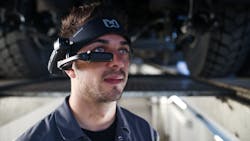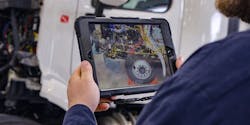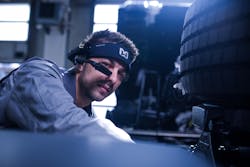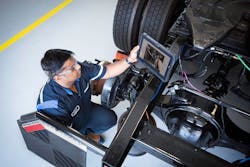This is Part Two of a two-part story. Read Part One here.
Whether through tablet-based programs that can provide a technician with x-ray vision or via head-worn wearable devices that keep critical technical information at eye level while they work, augmented reality has demonstrated the ability to boost several facets of commercial vehicle maintenance.
Here are three use cases that illustrate how augmented reality is a now a real and viable driver of efficiency, productivity, and accuracy in the shop:
Use Case 1: Peterbilt Truck Parts & Equipment
Overall, Peterbilt dealer service technicians have reported time savings of up to 15 to 20% when using ARTech for repair work.
Peterbilt Truck Parts & Equipment, a dealership in Sparks, Nevada, has seen these benefits firsthand. But service manager Marty Makrdichian said the technology, while useful, was not quite what he had anticipated.
“I thought most of the diagnostics would be done through the tool,” Makrdichian said. “Years ago, I had seen another version that another OEM had used overseas. And I expected it to be a little bit more like that. But over here, we don’t necessarily need it the way they use it.”
The Sparks dealership largely uses the tool for visualizing digital wiring diagrams on physical vehicles. This simplified training.
“It’s extremely easy to use, it’s very straightforward,” Makrdichian explained. Indeed, the system was so easy that all the shop needed for training was “a couple of demonstrations from Peterbilt in early August.”
Given that ARTech is specifically meant to provide technical information on Peterbilt vehicles, the only early issue the Sparks location experienced was accessing updated technical information for their various assets, because Peterbilt uploads vehicle schematics into the program as they’re built. This meant that some truck series were included early on but others weren’t until the company could catch up.
Since then, the Sparks location has found ARTech to be invaluable in terms of diagnosing vehicles and speeding up the troubleshooting process, especially by removing the need to leave a vehicle and go through Peterbilt’s online program to find wiring diagrams.
“This is 10 times faster,” Makrdichian asserted of the ARTech process.
Makrdichian has also found the technology very useful for mobile repair applications.
“You may not have quick internet or you may be using the hotspot off your phone, but now, before you go, you can pre-load the truck that you’re going to work on, then you’ll have all of the schematics you need,” Makrdichian said. “And in Nevada, there’s a lot of remote areas, so it’s very helpful here. We’ll be out in a gold mine somewhere, and there’s no service, making this a very helpful tool.”
As a result of this utility, the Sparks service manager reported that they expected to see more ARTech-enabled iPads in their shop soon.
“We’re expanding our facility right now and adding another 20 bays,” Makrdichian said. “There will absolutely be a couple more of these implemented. And every mobile service vehicle that we have is equipped with one, so any additional mobile service units that we have, I will put one on their truck as well.”
Use Case 2: MHS Truck & Bus
MHS Truck & Bus, the sole distributor of MAN commercial vehicles in Romania, has nine locations across the country, the closest of which is almost 200 miles from the company’s Bucharest headquarters. One of its newer shops is 365 miles away in Oradea, and it’s not easy for a technical expert from HQ to get there to assist with complex repairs or issues. While certainly a picturesque journey, the route is filled with precarious mountain roads and can take nine hours.
Read more: Hands-on maintenance gets assist from hands-free wearable computerThe company has stated that travel time for their two seasoned technicians can equate to roughly 40 hours and 1,200 miles per month. That’s a lot of added downtime and efficiency sacrificed on the altar of in-person communication, let alone while in the midst of a pandemic.
But Marius Scutaru, MHS’ head of customer service management, and business partner Mihai Danila, GM at Seth Dynamics SRL, were certain that this did not have to be the organization’s status quo.
In 2021 MHS Truck & Bus became aware of RealWear’s HMT-1. The wearable, voice-activated device provides contextual information through an adjustable monocular display attached to the headset. The wiring diagram stays 2D, unlike Peterbilt's ARTech, but it is always in the tech’s field of view and the user’s hands are always free to perform the PM or repair.
The selling point for MHS was the connectivity aspect. Through Wi-Fi, 4G, or Bluetooth, a tech stumped by a diagnostic issue can verbally command the HMT-1 to connect to a specific expert anywhere in the world for help. The expert can then see the tech’s point-of-view from a laptop or tablet and talk them through the repair while attaching relevant files or marking up screen shots to target areas of interest.
“We saw that this device could help us overcome some issues that we have in our network.” Scutaru said.
In November 2021, MHS began piloting the HMT-1 and sent headsets to the Oradea shop, where they deemed that the need was highest. This was partly to address the massive travel times, but it was not the only issue MHS Truck & Bus hoped that their AR program would address.
Each location was receiving more and more trucks with increasingly complex aftertreatment systems to meet growing emissions requirements, as well as customer calls for increased fuel efficiency, advanced driver assistance systems (ADAS), technology integration, and fleet maintenance management, Scutaru noted. This is what lead to the company contacting RealWear.
“The main reason was the continuously increasing gap between the complexity of the vehicles and the experience and expertise of our technicians,” Scutaru said.
By making updated vehicle information and expert assistance readily available for the Oradea workshop via the HMT-1, MHS Truck & Bus hoped to cut the downtime of the vehicles in the workshop.
After three months with the initial headset, the feedback was so positive that Scutaru decided to implement the technology in their other locations as well, which the company later reported helped reduce the diagnosis time of vehicle repairs by 75% and travel time by 50%.
“We’ve experienced lots of benefits in terms of travel time and fuel consumption for our experts and also our customers, who have already had the benefits of shorter downtime for their vehicles at every workshop they visited,” Scutaru affirmed.
The total hardware investment for the 10 units purchased was about $22,000, Scutaru noted. This cost does not entirely account for the training and delivery logistics of obtaining more HMT-1 headsets, for which MHS Truck & Bus partnered with Danila and his team at Seth Dynamics.
“The training was done more or less for workshop managers in every location, one by one, depending on their timetable because they are pretty busy guys with lots to do,” Danila recalled. “It was hard to get them all in one place. Ninety percent of the training was actually done online.”
During the process, Scutaru found that the company also had to work around some employees’ resistance to change.
“To be honest, the most important challenge was to overcome the reluctance of the people in using new technologies, because I know they prefer traditional communication channels like phone, WhatsApp, email, etc.,” Scutaru explained.
The techs also had grown accustomed to their Windows phones. “They were managing to do their job well from their perspective, but not my perspective,” Danila offered.
Danila found another challenge was establishing the necessary infrastructure, as the live feed wasn’t reliable.
“There were some network connectivity problems, which we solved in each location,” Danila said. This was done through additional infrastructure investments.
After the initial installation, both Scutaru and Danila found that their technicians in each location were consistently using the HMT-1 headset roughly 2 to 3 times per month.
“You are using the devices less and less because you are more knowledgeable,” Danila explained. “And you can solve things much more easily. You are only using it when something is changing, when you have to deal with new things or you need a higher level of support.”
But even with their devices experiencing peaks and valleys of use, from Scutaru and Danila’s perspective, the continuous evolution of the repair industry guarantees AR technology’s viability in MHS Truck & Bus’ shops and, just as importantly, on the road.
“We are planning to extend the application on remote repairs in case of breakdowns,” Scutaru noted. “When we have calls from our customers and we need to allocate a technician to go there, we might have very little information regarding the vehicle, and sometimes we cannot allocate a technician whose expertise and experience is strongly correlated with the complexity of the damage. That’s why they should have the possibility to use this device to solve the problem without coming back to the workshop.”
Use Case 3: Penske Truck Leasing
Penske first began its foray into the world of AR during the pandemic, which complicated the company’s training operations.
“During the pandemic, as a technical training team with an audience of technicians, we learned very quickly that using certain types of virtual platforms for engaging with associates in a training atmosphere was not really the best scenario for learning,” said Holly Gerke, VP of maintenance, technical training, and development, Penske Truck Leasing.
As such, the company began to explore other ways to deliver its training and began using Design Interactive’s XRMentor platform in September of 2021.
“The real expectation, once we learned more about the technology, was that we were trying to upskill our entry-level workforce at a much quicker pace than we’ve ever been able to realize before,” Gerke said.
However, Penske needed to ensure their infrastructure was ready for the demands of AR before they could reap the rewards.
“There was some lifting with technology as far as our infrastructure, working with other teams in our organization like security, IT, and working on the network, so there are some things that we had to really look at,” Gerke said. “When you insert a piece of technology like this into a training infrastructure that already consumes so much bandwidth, you’re putting another piece of technology on top of something that’s already strained.”
But verifying that their network could handle the increased demands of XRMentor’s visual streaming was critical, “because the benefit of XRMentor and this technology is its live feed,” Gerke emphasized. “Supporting that live stream within our locations was honestly the biggest thing that we had to solve for, because if it wasn’t streaming correctly, then we all know what happens to the end-user experience: It degrades, things are choppy, you can’t hear everything. And during our pilot, that’s what we were really stress testing: the infrastructure across the organization.”
But once these hurdles were overcome, Gerke reported that implementing XRMentor with Penske’s incoming class of entry-level technicians was very smooth, especially as they took to the new technology far faster than Gerke and her team expected.
“A lot of them are used to electronic devices, they’re used to learning through a virtual experience,” Gerke stated. “So, getting their support was quite easy.”
Even more so, the feedback Gerke has received from their technicians using XRMentor has been overwhelmingly positive, with technicians stating that their training through the AR technology has been engaging, clear, and a very different experience from gathering eight people around a single vehicle. Even more so, Gerke stated that the company has cut its training time in half.
However, Gerke and her team were concerned that the effectiveness of the virtually-assisted training might pale in comparison to the depth of learning that an entry-level technician might get from a fully in-person experience. But the repair data and inspection rates with technicians after their XRMentor sessions have revealed positive rates in accuracy and completion.
“Not only are we getting the training to them more quickly, the most incredible thing that we are seeing in our repair data is that it’s working, it’s actually effective,” she said.
But along with these benefits, Gerke also stressed that AR’s potential for shops partially resides in its flexibility, a flexibility that Penske’s program needed to succeed.
“I would recommend that the smaller companies who may not have the ability to invest should start really small,” Gerke explained. “And also not necessarily use the technology as it’s been marketed to do. When we entered it, we were not comfortable making an investment where every technician in the shop would be wearing these devices. However, we were able to work with Design Interactive to limit the number of people who had the device.”
About the Author

Alex Keenan
Alex Keenan is an Associate Editor for Fleet Maintenance magazine. She has written on a variety of topics for the past several years and recently joined the transportation industry, reviewing content covering technician challenges and breaking industry news. She holds a bachelor's degree in English from Colorado State University in Fort Collins, Colorado.




